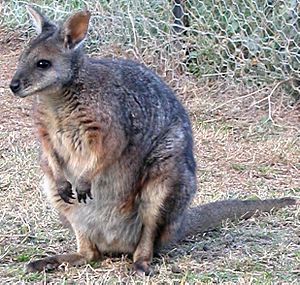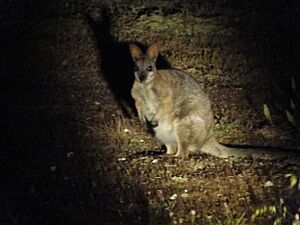Tammar wallaby facts for kids
Quick facts for kids Tammar wallaby |
|
|---|---|
 |
|
| Conservation status | |
| Scientific classification | |
| Kingdom: | |
| Phylum: | |
| Class: | |
| Infraclass: | |
| Order: | |
| Family: | |
| Genus: | |
| Binomial name | |
| Macropus eugenii Desmarest, 1817
|
|
The tammar wallaby (Macropus eugenii) is a small wallaby from Australia. It was one of the first macropods that Europeans ever saw. In 1629, a captain named Francisco Pelsaert saw them. His ship, the Batavia, was wrecked on the Abrolhos Islands. He said the wallabies looked like hopping cats!
There are three main types, or subspecies, of tammar wallaby:
- M. e. eugenii lives in mainland South Australia.
- M. e. derbianus lives in Western Australia.
- M. e. decres, also called the darma or dama wallaby, lives on Kangaroo Island, South Australia.
The name "tammar" comes from the word tamma. This word means "sheoak," which is a type of plant. The wallaby often lives under these sheoak plants.
Contents
Tammar Wallaby: A Comeback Story
Tammar wallabies disappeared from mainland South Australia in the 1930s. This happened because their homes were destroyed, people hunted them, and foxes were a danger.
But in 1998, a small group of these wallabies was found! They were living on Kawau Island in New Zealand. This group had been brought there in 1862 by Sir George Grey, a former governor. He wanted them for his private zoo.
In New Zealand, these wallabies were seen as a problem. Scientists were looking for ways to control their numbers. So, 85 wallabies were brought back to South Australia. After a lot of work to control foxes at Innes National Park, 10 wallabies were set free in November 2004. Another 36 were released in June 2005. Scientists tracked these wallabies with special radio collars. Another group of wallabies was put into a special breeding program at Monarto Safari Park. This helps make sure more wallabies are born safely.
Where Tammar Wallabies Live and What They Eat
Tammar wallabies like to live in thick bushes during the day. At night, they come out into open grassy areas to find food. They mostly eat grass and other small plants. In very dry places, they have even been seen drinking seawater to survive! They usually move around in an area of about 5 hectares (about 12 acres).
These wallabies are about 50 cm (20 inches) tall. They have dark grey-brown fur. Their arms and sides have a reddish color. Their bellies are a pale grey. Sometimes, they even have a faint white line on their cheeks.
Reproduction and Life Cycle
Tammar wallabies have a very interesting way of having babies. After the egg is fertilized, it stays "asleep" inside the mother. This is called "embryonic diapause." The baby's development only starts again around the summer solstice (the longest day of the year).
Then, about 31 days later, all the young wallabies are born on the same day! This usually happens at the end of January or beginning of February.
Why Tammar Wallabies Are Important to Science
The tammar wallaby is a very special animal for scientists. It was chosen for a big project to map its entire genome. A genome is like a complete set of instructions for building an animal.
Scientists are also studying the milk from the wallaby. They think it might contain a new and very strong antibiotic. Antibiotics are medicines that fight off bad germs.
Images for kids
-
A drawing of two tammar wallabies by John Gould (1863)
-
A tammar wallaby on North Island in the Houtman Abrolhos
See also
 In Spanish: Ualabí de Tammar para niños
In Spanish: Ualabí de Tammar para niños










